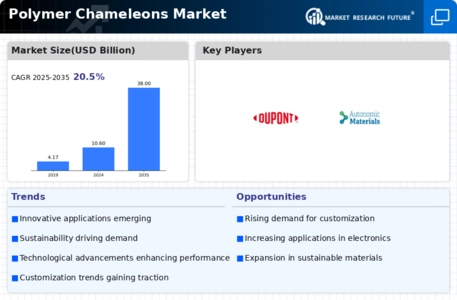Market Trends
Key Emerging Trends in the Polymer Chameleons Market
Additionally referred to as smart polymers, polymer chameleons are discovering an expanding number of applications in the world of biomedicine. These polymers have the ability to react to external stimuli such as temperature, pH, or light, which makes them useful for applications such as controlled release, tissue engineering, and drug delivery systems. The increased requirement for accurate and sensitive materials in the biomedical industry is the primary factor driving the expansion of polymer chameleons in this particular field. Depending on the parameters of the surrounding environment, these polymers are able to alter their physical characteristics, which enables them to provide advantages such as self-healing packaging and sophisticated sensors for determining whether or not something is fresh. As a result of their capacity to extend the shelf life of food and cut down on food waste, polymer chameleons are becoming an increasingly disruptive trend in the packaging industry. Polymer chameleons provide a significant contribution to the growing interest in environmentally responsible practices within the polymer sector. In order to build environmentally friendly materials that include capabilities such as biodegradability and recyclability, it is possible to make use of their ability to react to environmental stimuli. As worries about the environment become increasingly pressing, polymer chameleons are falling in line with the industry's movement toward alternatives that are more environmentally friendly and sustainable. For the purpose of developing adaptable materials and smart textiles, the textile and wearable technology sectors are adding polymer chameleons. The ability of these polymers to react to changes in temperature or moisture levels brings improvements in the comfort and functionality of clothes. Additionally, polymer chameleons are being employed for responsive sensors and components in wearable devices, which is pushing innovation in the area of smart wearables, which is quickly growing. Specifically, the creation of intelligent agricultural materials is one area in which polymer chameleons are finding uses in the agricultural industry. These polymers have the ability to react to the conditions of the soil, whether it is temperature or humidity, which allows them to create intelligent pesticide delivery systems and agricultural films that are sensitive. In order to develop more sophisticated drug delivery systems, the pharmaceutical sector is making use of the responsive features of polymer chameleons. In response to certain physiological variables that are present inside the body, these systems are able to release medications in a way that is both regulated and targeted. Polymer chameleons have emerged as an important instrument in the field of pharmaceutical research and development due to their capacity to improve therapeutic effectiveness while simultaneously reducing related adverse effects. The commercialization and scaling up of polymer chameleons face hurdles, despite the fact that the applications of these materials are quite promising. There may be obstacles to wider adoption, such as the difficulty of creating responsive polymers with consistent characteristics and the high cost of manufacture. Polymer chameleons have been the subject of much research and study, with the primary objective being the development of materials that are sensitive to several stimuli. It is possible to achieve more adaptability and application using polymers that are capable of reacting concurrently to environmental stimuli, such as temperature and pH. In the future of this new material class, one trend that is defining the future is the search of polymers that are sensitive to many stimuli.





Leave a Comment